Feasibility Study of Solar Energy Infrastructure Project in Australia
VerifiedAdded on 2023/03/23
|34
|13206
|39
Report
AI Summary
This report presents a feasibility study of solar energy infrastructure in Australia, focusing on the potential for renewable energy development and reduction of greenhouse gas emissions. It examines the current energy landscape, including the role of coal-fired power plants and the need for new energy sources. The study analyzes the impact of government policies, such as the Renewable Energy Target (RET), and assesses the effectiveness of various incentives for solar photovoltaic (PV) installations. It also evaluates the economic viability of solar energy projects using the Levelized Cost of Energy (LCOE) methodology, addressing common misconceptions and providing recommendations for accurate reporting. The report further explores the background of energy consumption trends, the significance of energy security, environmental protection, and economic competitiveness. Finally, it highlights the importance of research and development in photovoltaic technologies to achieve goals of reducing reliance on fossil fuels and mitigating climate change.
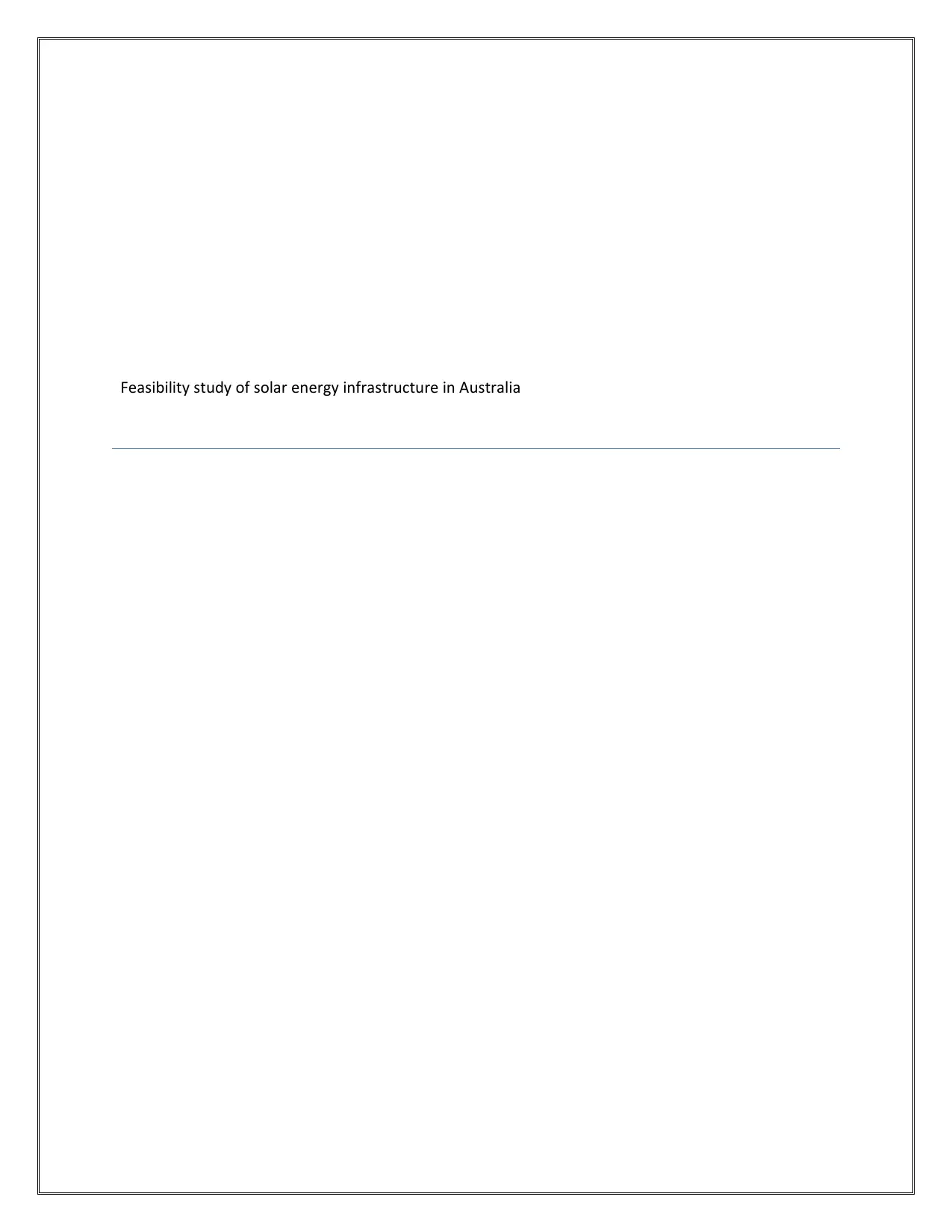
Feasibility study of solar energy infrastructure in Australia
Paraphrase This Document
Need a fresh take? Get an instant paraphrase of this document with our AI Paraphraser
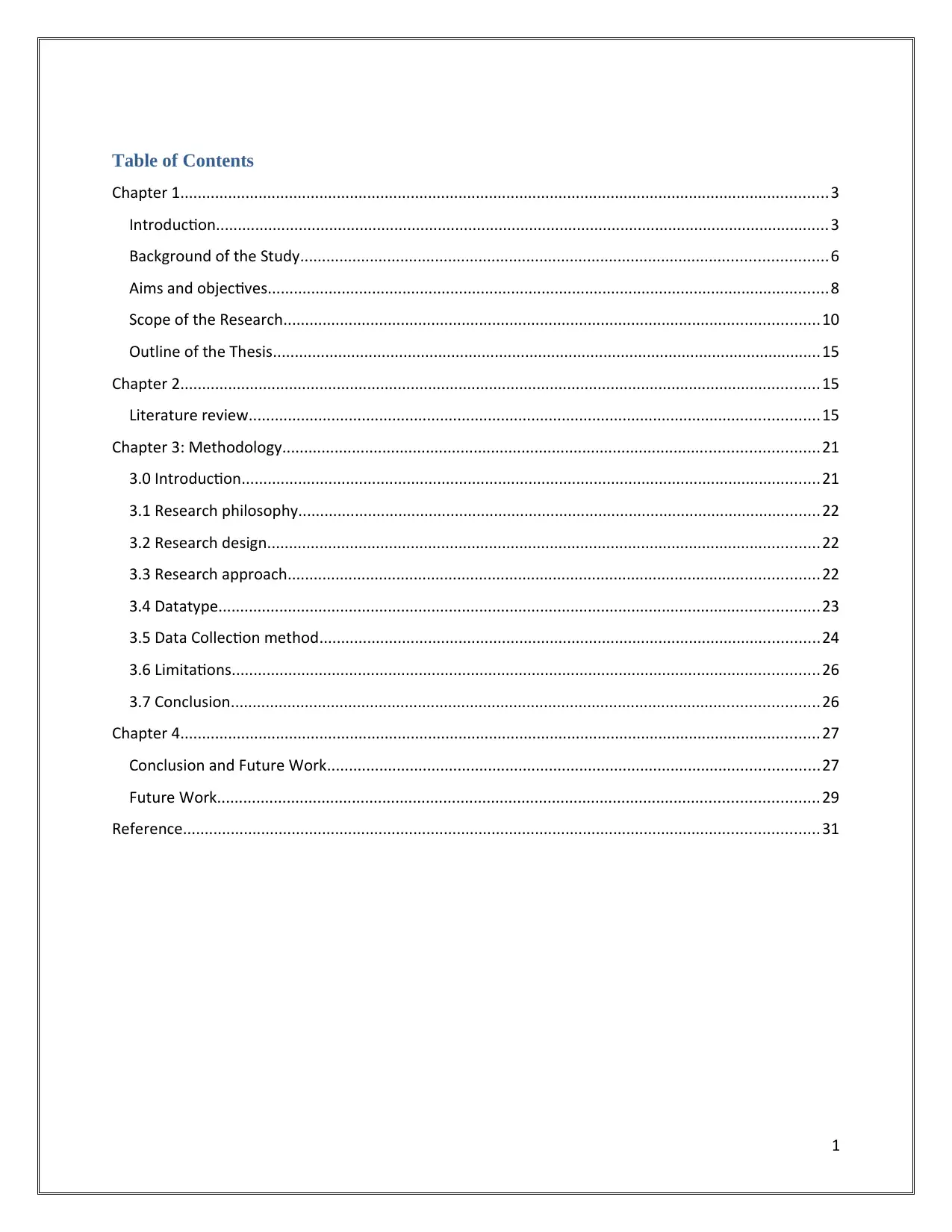
Table of Contents
Chapter 1.....................................................................................................................................................3
Introduction.............................................................................................................................................3
Background of the Study.........................................................................................................................6
Aims and objectives.................................................................................................................................8
Scope of the Research...........................................................................................................................10
Outline of the Thesis..............................................................................................................................15
Chapter 2...................................................................................................................................................15
Literature review...................................................................................................................................15
Chapter 3: Methodology...........................................................................................................................21
3.0 Introduction.....................................................................................................................................21
3.1 Research philosophy........................................................................................................................22
3.2 Research design...............................................................................................................................22
3.3 Research approach..........................................................................................................................22
3.4 Datatype..........................................................................................................................................23
3.5 Data Collection method...................................................................................................................24
3.6 Limitations.......................................................................................................................................26
3.7 Conclusion.......................................................................................................................................26
Chapter 4...................................................................................................................................................27
Conclusion and Future Work.................................................................................................................27
Future Work..........................................................................................................................................29
Reference..................................................................................................................................................31
1
Chapter 1.....................................................................................................................................................3
Introduction.............................................................................................................................................3
Background of the Study.........................................................................................................................6
Aims and objectives.................................................................................................................................8
Scope of the Research...........................................................................................................................10
Outline of the Thesis..............................................................................................................................15
Chapter 2...................................................................................................................................................15
Literature review...................................................................................................................................15
Chapter 3: Methodology...........................................................................................................................21
3.0 Introduction.....................................................................................................................................21
3.1 Research philosophy........................................................................................................................22
3.2 Research design...............................................................................................................................22
3.3 Research approach..........................................................................................................................22
3.4 Datatype..........................................................................................................................................23
3.5 Data Collection method...................................................................................................................24
3.6 Limitations.......................................................................................................................................26
3.7 Conclusion.......................................................................................................................................26
Chapter 4...................................................................................................................................................27
Conclusion and Future Work.................................................................................................................27
Future Work..........................................................................................................................................29
Reference..................................................................................................................................................31
1
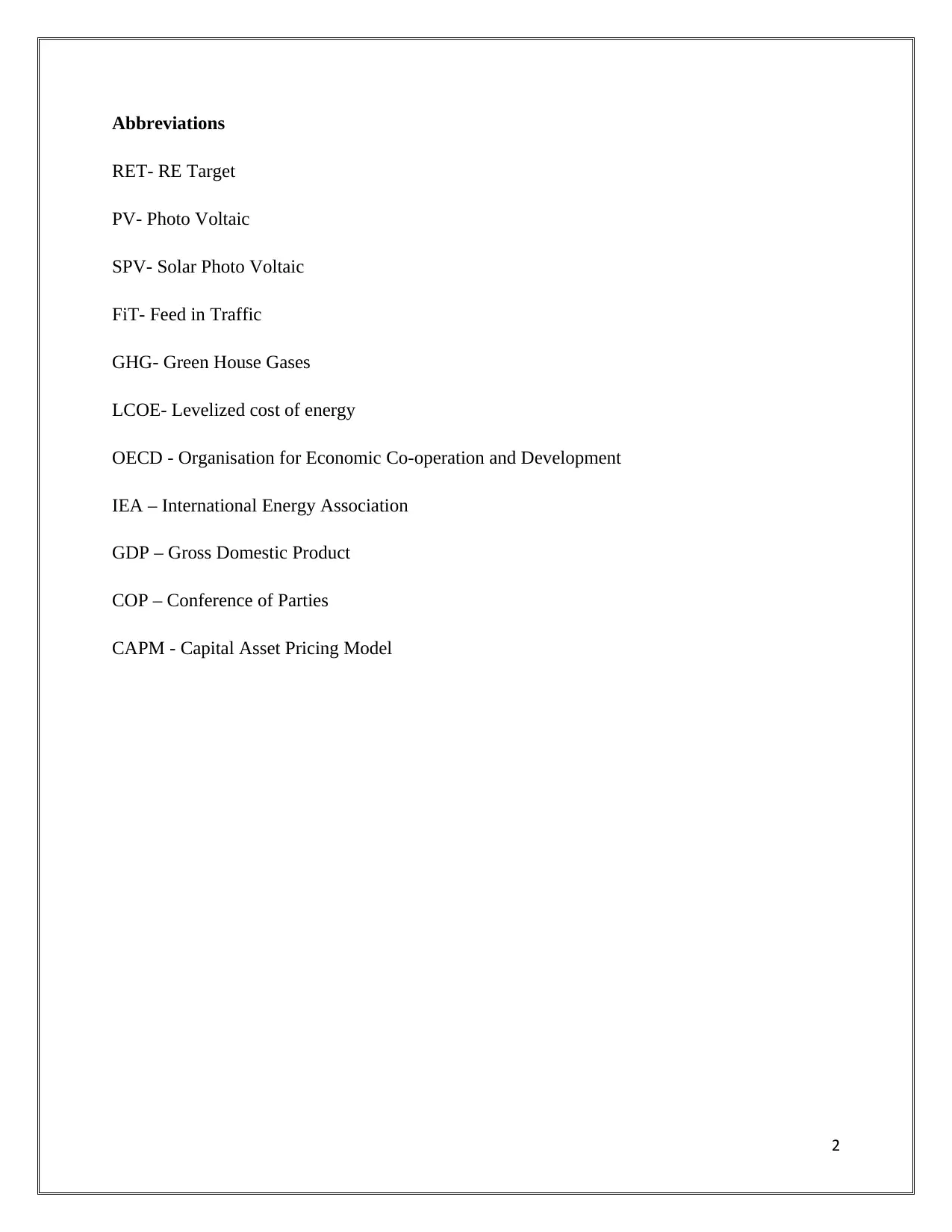
Abbreviations
RET- RE Target
PV- Photo Voltaic
SPV- Solar Photo Voltaic
FiT- Feed in Traffic
GHG- Green House Gases
LCOE- Levelized cost of energy
OECD - Organisation for Economic Co-operation and Development
IEA – International Energy Association
GDP – Gross Domestic Product
COP – Conference of Parties
CAPM - Capital Asset Pricing Model
2
RET- RE Target
PV- Photo Voltaic
SPV- Solar Photo Voltaic
FiT- Feed in Traffic
GHG- Green House Gases
LCOE- Levelized cost of energy
OECD - Organisation for Economic Co-operation and Development
IEA – International Energy Association
GDP – Gross Domestic Product
COP – Conference of Parties
CAPM - Capital Asset Pricing Model
2
⊘ This is a preview!⊘
Do you want full access?
Subscribe today to unlock all pages.

Trusted by 1+ million students worldwide
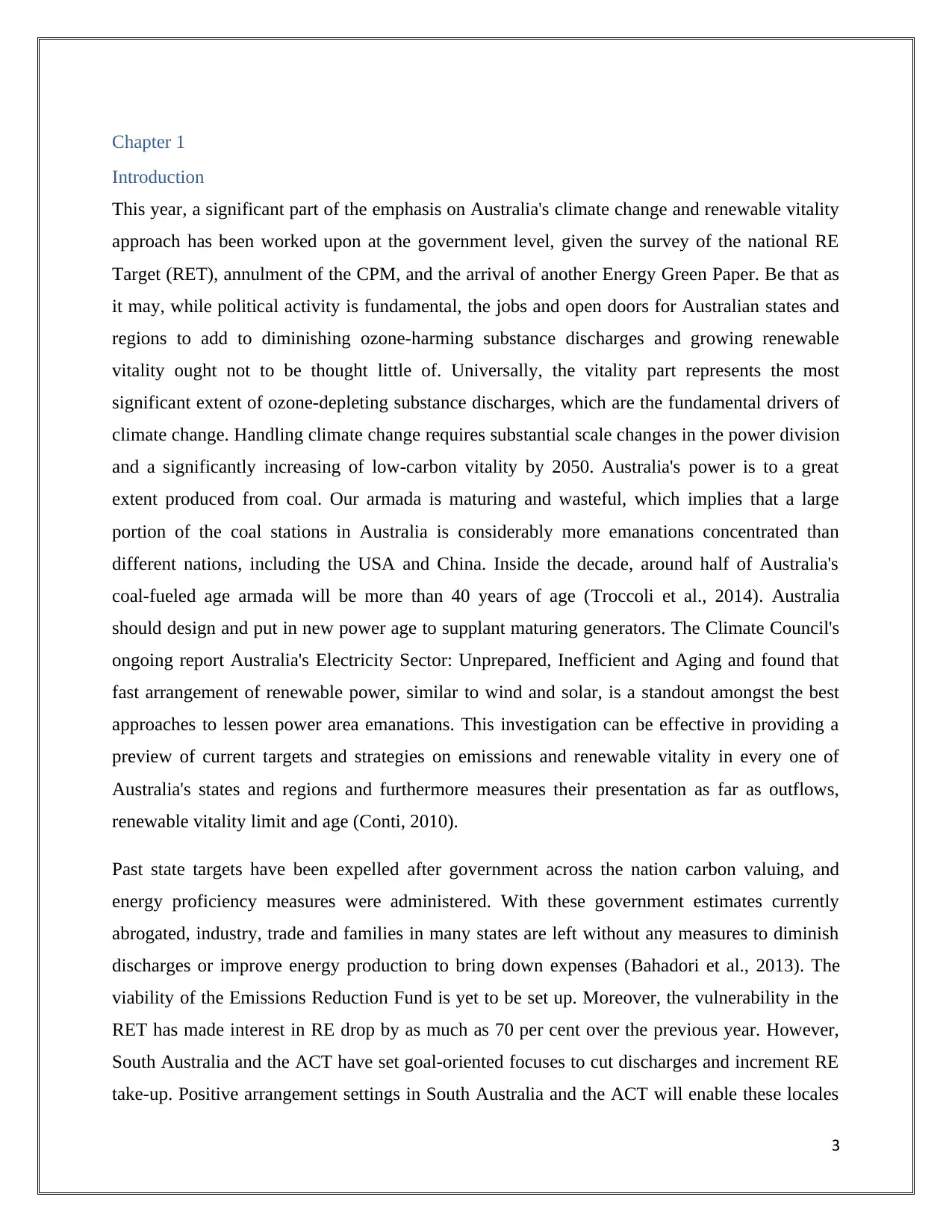
Chapter 1
Introduction
This year, a significant part of the emphasis on Australia's climate change and renewable vitality
approach has been worked upon at the government level, given the survey of the national RE
Target (RET), annulment of the CPM, and the arrival of another Energy Green Paper. Be that as
it may, while political activity is fundamental, the jobs and open doors for Australian states and
regions to add to diminishing ozone-harming substance discharges and growing renewable
vitality ought not to be thought little of. Universally, the vitality part represents the most
significant extent of ozone-depleting substance discharges, which are the fundamental drivers of
climate change. Handling climate change requires substantial scale changes in the power division
and a significantly increasing of low-carbon vitality by 2050. Australia's power is to a great
extent produced from coal. Our armada is maturing and wasteful, which implies that a large
portion of the coal stations in Australia is considerably more emanations concentrated than
different nations, including the USA and China. Inside the decade, around half of Australia's
coal-fueled age armada will be more than 40 years of age (Troccoli et al., 2014). Australia
should design and put in new power age to supplant maturing generators. The Climate Council's
ongoing report Australia's Electricity Sector: Unprepared, Inefficient and Aging and found that
fast arrangement of renewable power, similar to wind and solar, is a standout amongst the best
approaches to lessen power area emanations. This investigation can be effective in providing a
preview of current targets and strategies on emissions and renewable vitality in every one of
Australia's states and regions and furthermore measures their presentation as far as outflows,
renewable vitality limit and age (Conti, 2010).
Past state targets have been expelled after government across the nation carbon valuing, and
energy proficiency measures were administered. With these government estimates currently
abrogated, industry, trade and families in many states are left without any measures to diminish
discharges or improve energy production to bring down expenses (Bahadori et al., 2013). The
viability of the Emissions Reduction Fund is yet to be set up. Moreover, the vulnerability in the
RET has made interest in RE drop by as much as 70 per cent over the previous year. However,
South Australia and the ACT have set goal-oriented focuses to cut discharges and increment RE
take-up. Positive arrangement settings in South Australia and the ACT will enable these locales
3
Introduction
This year, a significant part of the emphasis on Australia's climate change and renewable vitality
approach has been worked upon at the government level, given the survey of the national RE
Target (RET), annulment of the CPM, and the arrival of another Energy Green Paper. Be that as
it may, while political activity is fundamental, the jobs and open doors for Australian states and
regions to add to diminishing ozone-harming substance discharges and growing renewable
vitality ought not to be thought little of. Universally, the vitality part represents the most
significant extent of ozone-depleting substance discharges, which are the fundamental drivers of
climate change. Handling climate change requires substantial scale changes in the power division
and a significantly increasing of low-carbon vitality by 2050. Australia's power is to a great
extent produced from coal. Our armada is maturing and wasteful, which implies that a large
portion of the coal stations in Australia is considerably more emanations concentrated than
different nations, including the USA and China. Inside the decade, around half of Australia's
coal-fueled age armada will be more than 40 years of age (Troccoli et al., 2014). Australia
should design and put in new power age to supplant maturing generators. The Climate Council's
ongoing report Australia's Electricity Sector: Unprepared, Inefficient and Aging and found that
fast arrangement of renewable power, similar to wind and solar, is a standout amongst the best
approaches to lessen power area emanations. This investigation can be effective in providing a
preview of current targets and strategies on emissions and renewable vitality in every one of
Australia's states and regions and furthermore measures their presentation as far as outflows,
renewable vitality limit and age (Conti, 2010).
Past state targets have been expelled after government across the nation carbon valuing, and
energy proficiency measures were administered. With these government estimates currently
abrogated, industry, trade and families in many states are left without any measures to diminish
discharges or improve energy production to bring down expenses (Bahadori et al., 2013). The
viability of the Emissions Reduction Fund is yet to be set up. Moreover, the vulnerability in the
RET has made interest in RE drop by as much as 70 per cent over the previous year. However,
South Australia and the ACT have set goal-oriented focuses to cut discharges and increment RE
take-up. Positive arrangement settings in South Australia and the ACT will enable these locales
3
Paraphrase This Document
Need a fresh take? Get an instant paraphrase of this document with our AI Paraphraser
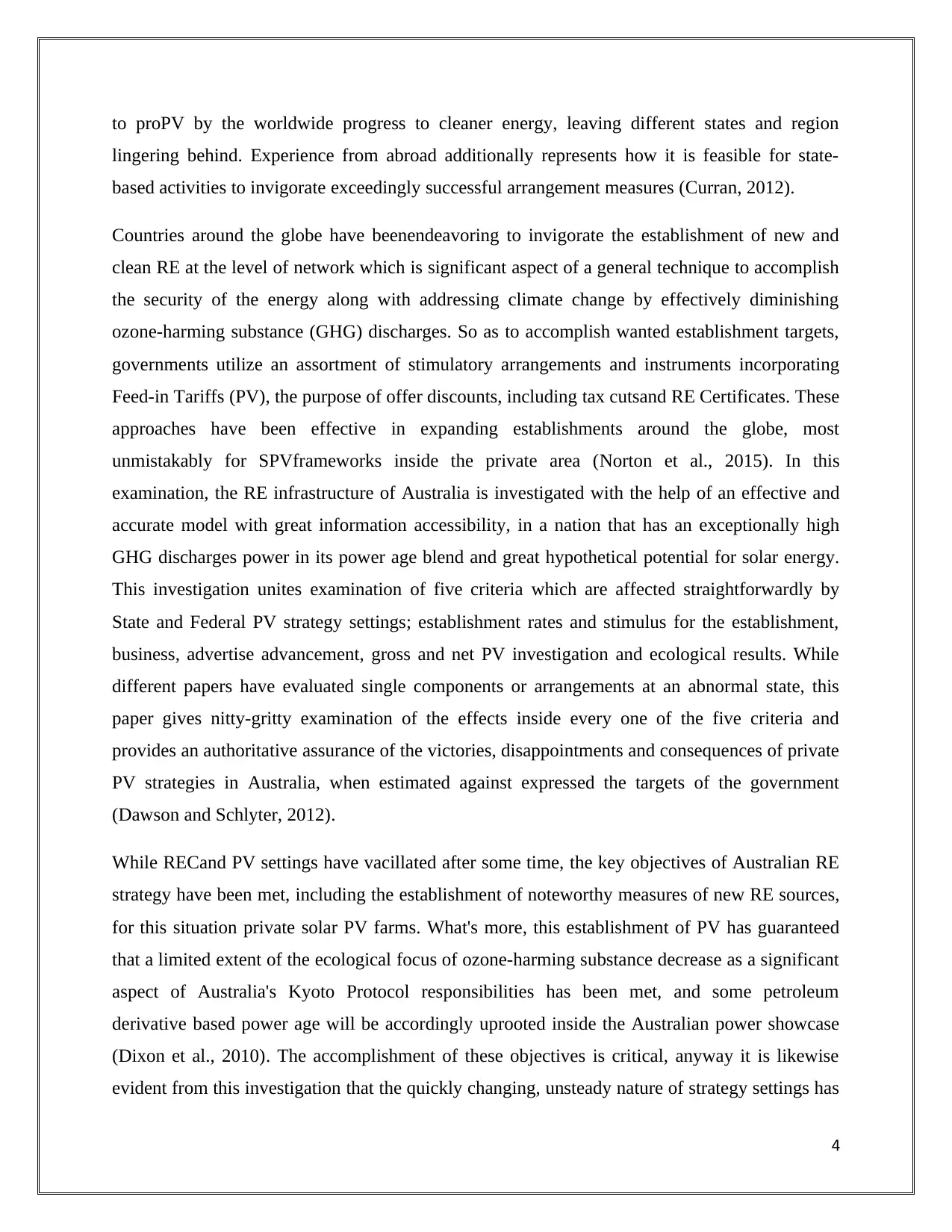
to proPV by the worldwide progress to cleaner energy, leaving different states and region
lingering behind. Experience from abroad additionally represents how it is feasible for state-
based activities to invigorate exceedingly successful arrangement measures (Curran, 2012).
Countries around the globe have beenendeavoring to invigorate the establishment of new and
clean RE at the level of network which is significant aspect of a general technique to accomplish
the security of the energy along with addressing climate change by effectively diminishing
ozone-harming substance (GHG) discharges. So as to accomplish wanted establishment targets,
governments utilize an assortment of stimulatory arrangements and instruments incorporating
Feed-in Tariffs (PV), the purpose of offer discounts, including tax cutsand RE Certificates. These
approaches have been effective in expanding establishments around the globe, most
unmistakably for SPVframeworks inside the private area (Norton et al., 2015). In this
examination, the RE infrastructure of Australia is investigated with the help of an effective and
accurate model with great information accessibility, in a nation that has an exceptionally high
GHG discharges power in its power age blend and great hypothetical potential for solar energy.
This investigation unites examination of five criteria which are affected straightforwardly by
State and Federal PV strategy settings; establishment rates and stimulus for the establishment,
business, advertise advancement, gross and net PV investigation and ecological results. While
different papers have evaluated single components or arrangements at an abnormal state, this
paper gives nitty-gritty examination of the effects inside every one of the five criteria and
provides an authoritative assurance of the victories, disappointments and consequences of private
PV strategies in Australia, when estimated against expressed the targets of the government
(Dawson and Schlyter, 2012).
While RECand PV settings have vacillated after some time, the key objectives of Australian RE
strategy have been met, including the establishment of noteworthy measures of new RE sources,
for this situation private solar PV farms. What's more, this establishment of PV has guaranteed
that a limited extent of the ecological focus of ozone-harming substance decrease as a significant
aspect of Australia's Kyoto Protocol responsibilities has been met, and some petroleum
derivative based power age will be accordingly uprooted inside the Australian power showcase
(Dixon et al., 2010). The accomplishment of these objectives is critical, anyway it is likewise
evident from this investigation that the quickly changing, unsteady nature of strategy settings has
4
lingering behind. Experience from abroad additionally represents how it is feasible for state-
based activities to invigorate exceedingly successful arrangement measures (Curran, 2012).
Countries around the globe have beenendeavoring to invigorate the establishment of new and
clean RE at the level of network which is significant aspect of a general technique to accomplish
the security of the energy along with addressing climate change by effectively diminishing
ozone-harming substance (GHG) discharges. So as to accomplish wanted establishment targets,
governments utilize an assortment of stimulatory arrangements and instruments incorporating
Feed-in Tariffs (PV), the purpose of offer discounts, including tax cutsand RE Certificates. These
approaches have been effective in expanding establishments around the globe, most
unmistakably for SPVframeworks inside the private area (Norton et al., 2015). In this
examination, the RE infrastructure of Australia is investigated with the help of an effective and
accurate model with great information accessibility, in a nation that has an exceptionally high
GHG discharges power in its power age blend and great hypothetical potential for solar energy.
This investigation unites examination of five criteria which are affected straightforwardly by
State and Federal PV strategy settings; establishment rates and stimulus for the establishment,
business, advertise advancement, gross and net PV investigation and ecological results. While
different papers have evaluated single components or arrangements at an abnormal state, this
paper gives nitty-gritty examination of the effects inside every one of the five criteria and
provides an authoritative assurance of the victories, disappointments and consequences of private
PV strategies in Australia, when estimated against expressed the targets of the government
(Dawson and Schlyter, 2012).
While RECand PV settings have vacillated after some time, the key objectives of Australian RE
strategy have been met, including the establishment of noteworthy measures of new RE sources,
for this situation private solar PV farms. What's more, this establishment of PV has guaranteed
that a limited extent of the ecological focus of ozone-harming substance decrease as a significant
aspect of Australia's Kyoto Protocol responsibilities has been met, and some petroleum
derivative based power age will be accordingly uprooted inside the Australian power showcase
(Dixon et al., 2010). The accomplishment of these objectives is critical, anyway it is likewise
evident from this investigation that the quickly changing, unsteady nature of strategy settings has
4
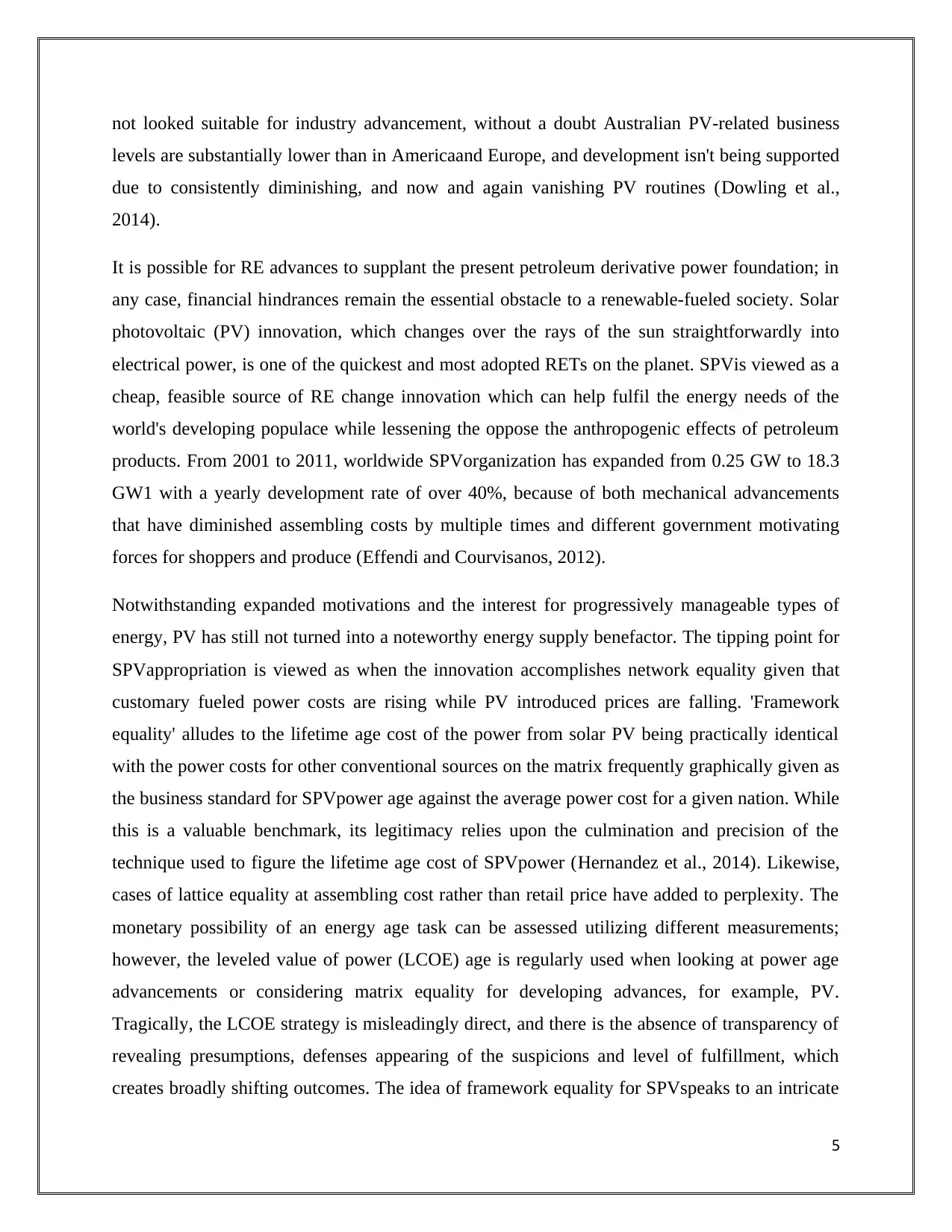
not looked suitable for industry advancement, without a doubt Australian PV-related business
levels are substantially lower than in Americaand Europe, and development isn't being supported
due to consistently diminishing, and now and again vanishing PV routines (Dowling et al.,
2014).
It is possible for RE advances to supplant the present petroleum derivative power foundation; in
any case, financial hindrances remain the essential obstacle to a renewable-fueled society. Solar
photovoltaic (PV) innovation, which changes over the rays of the sun straightforwardly into
electrical power, is one of the quickest and most adopted RETs on the planet. SPVis viewed as a
cheap, feasible source of RE change innovation which can help fulfil the energy needs of the
world's developing populace while lessening the oppose the anthropogenic effects of petroleum
products. From 2001 to 2011, worldwide SPVorganization has expanded from 0.25 GW to 18.3
GW1 with a yearly development rate of over 40%, because of both mechanical advancements
that have diminished assembling costs by multiple times and different government motivating
forces for shoppers and produce (Effendi and Courvisanos, 2012).
Notwithstanding expanded motivations and the interest for progressively manageable types of
energy, PV has still not turned into a noteworthy energy supply benefactor. The tipping point for
SPVappropriation is viewed as when the innovation accomplishes network equality given that
customary fueled power costs are rising while PV introduced prices are falling. 'Framework
equality' alludes to the lifetime age cost of the power from solar PV being practically identical
with the power costs for other conventional sources on the matrix frequently graphically given as
the business standard for SPVpower age against the average power cost for a given nation. While
this is a valuable benchmark, its legitimacy relies upon the culmination and precision of the
technique used to figure the lifetime age cost of SPVpower (Hernandez et al., 2014). Likewise,
cases of lattice equality at assembling cost rather than retail price have added to perplexity. The
monetary possibility of an energy age task can be assessed utilizing different measurements;
however, the leveled value of power (LCOE) age is regularly used when looking at power age
advancements or considering matrix equality for developing advances, for example, PV.
Tragically, the LCOE strategy is misleadingly direct, and there is the absence of transparency of
revealing presumptions, defenses appearing of the suspicions and level of fulfillment, which
creates broadly shifting outcomes. The idea of framework equality for SPVspeaks to an intricate
5
levels are substantially lower than in Americaand Europe, and development isn't being supported
due to consistently diminishing, and now and again vanishing PV routines (Dowling et al.,
2014).
It is possible for RE advances to supplant the present petroleum derivative power foundation; in
any case, financial hindrances remain the essential obstacle to a renewable-fueled society. Solar
photovoltaic (PV) innovation, which changes over the rays of the sun straightforwardly into
electrical power, is one of the quickest and most adopted RETs on the planet. SPVis viewed as a
cheap, feasible source of RE change innovation which can help fulfil the energy needs of the
world's developing populace while lessening the oppose the anthropogenic effects of petroleum
products. From 2001 to 2011, worldwide SPVorganization has expanded from 0.25 GW to 18.3
GW1 with a yearly development rate of over 40%, because of both mechanical advancements
that have diminished assembling costs by multiple times and different government motivating
forces for shoppers and produce (Effendi and Courvisanos, 2012).
Notwithstanding expanded motivations and the interest for progressively manageable types of
energy, PV has still not turned into a noteworthy energy supply benefactor. The tipping point for
SPVappropriation is viewed as when the innovation accomplishes network equality given that
customary fueled power costs are rising while PV introduced prices are falling. 'Framework
equality' alludes to the lifetime age cost of the power from solar PV being practically identical
with the power costs for other conventional sources on the matrix frequently graphically given as
the business standard for SPVpower age against the average power cost for a given nation. While
this is a valuable benchmark, its legitimacy relies upon the culmination and precision of the
technique used to figure the lifetime age cost of SPVpower (Hernandez et al., 2014). Likewise,
cases of lattice equality at assembling cost rather than retail price have added to perplexity. The
monetary possibility of an energy age task can be assessed utilizing different measurements;
however, the leveled value of power (LCOE) age is regularly used when looking at power age
advancements or considering matrix equality for developing advances, for example, PV.
Tragically, the LCOE strategy is misleadingly direct, and there is the absence of transparency of
revealing presumptions, defenses appearing of the suspicions and level of fulfillment, which
creates broadly shifting outcomes. The idea of framework equality for SPVspeaks to an intricate
5
⊘ This is a preview!⊘
Do you want full access?
Subscribe today to unlock all pages.

Trusted by 1+ million students worldwide
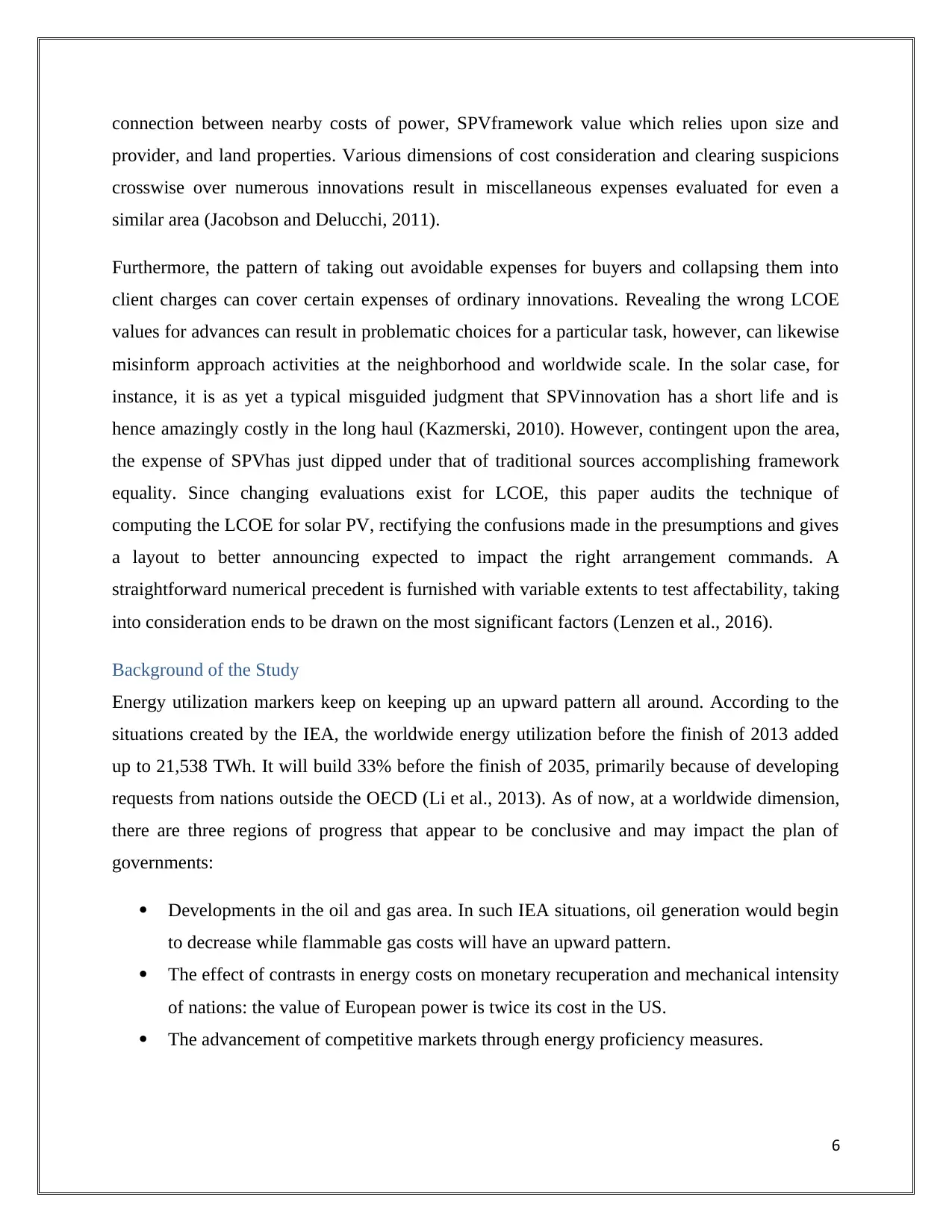
connection between nearby costs of power, SPVframework value which relies upon size and
provider, and land properties. Various dimensions of cost consideration and clearing suspicions
crosswise over numerous innovations result in miscellaneous expenses evaluated for even a
similar area (Jacobson and Delucchi, 2011).
Furthermore, the pattern of taking out avoidable expenses for buyers and collapsing them into
client charges can cover certain expenses of ordinary innovations. Revealing the wrong LCOE
values for advances can result in problematic choices for a particular task, however, can likewise
misinform approach activities at the neighborhood and worldwide scale. In the solar case, for
instance, it is as yet a typical misguided judgment that SPVinnovation has a short life and is
hence amazingly costly in the long haul (Kazmerski, 2010). However, contingent upon the area,
the expense of SPVhas just dipped under that of traditional sources accomplishing framework
equality. Since changing evaluations exist for LCOE, this paper audits the technique of
computing the LCOE for solar PV, rectifying the confusions made in the presumptions and gives
a layout to better announcing expected to impact the right arrangement commands. A
straightforward numerical precedent is furnished with variable extents to test affectability, taking
into consideration ends to be drawn on the most significant factors (Lenzen et al., 2016).
Background of the Study
Energy utilization markers keep on keeping up an upward pattern all around. According to the
situations created by the IEA, the worldwide energy utilization before the finish of 2013 added
up to 21,538 TWh. It will build 33% before the finish of 2035, primarily because of developing
requests from nations outside the OECD (Li et al., 2013). As of now, at a worldwide dimension,
there are three regions of progress that appear to be conclusive and may impact the plan of
governments:
Developments in the oil and gas area. In such IEA situations, oil generation would begin
to decrease while flammable gas costs will have an upward pattern.
The effect of contrasts in energy costs on monetary recuperation and mechanical intensity
of nations: the value of European power is twice its cost in the US.
The advancement of competitive markets through energy proficiency measures.
6
provider, and land properties. Various dimensions of cost consideration and clearing suspicions
crosswise over numerous innovations result in miscellaneous expenses evaluated for even a
similar area (Jacobson and Delucchi, 2011).
Furthermore, the pattern of taking out avoidable expenses for buyers and collapsing them into
client charges can cover certain expenses of ordinary innovations. Revealing the wrong LCOE
values for advances can result in problematic choices for a particular task, however, can likewise
misinform approach activities at the neighborhood and worldwide scale. In the solar case, for
instance, it is as yet a typical misguided judgment that SPVinnovation has a short life and is
hence amazingly costly in the long haul (Kazmerski, 2010). However, contingent upon the area,
the expense of SPVhas just dipped under that of traditional sources accomplishing framework
equality. Since changing evaluations exist for LCOE, this paper audits the technique of
computing the LCOE for solar PV, rectifying the confusions made in the presumptions and gives
a layout to better announcing expected to impact the right arrangement commands. A
straightforward numerical precedent is furnished with variable extents to test affectability, taking
into consideration ends to be drawn on the most significant factors (Lenzen et al., 2016).
Background of the Study
Energy utilization markers keep on keeping up an upward pattern all around. According to the
situations created by the IEA, the worldwide energy utilization before the finish of 2013 added
up to 21,538 TWh. It will build 33% before the finish of 2035, primarily because of developing
requests from nations outside the OECD (Li et al., 2013). As of now, at a worldwide dimension,
there are three regions of progress that appear to be conclusive and may impact the plan of
governments:
Developments in the oil and gas area. In such IEA situations, oil generation would begin
to decrease while flammable gas costs will have an upward pattern.
The effect of contrasts in energy costs on monetary recuperation and mechanical intensity
of nations: the value of European power is twice its cost in the US.
The advancement of competitive markets through energy proficiency measures.
6
Paraphrase This Document
Need a fresh take? Get an instant paraphrase of this document with our AI Paraphraser
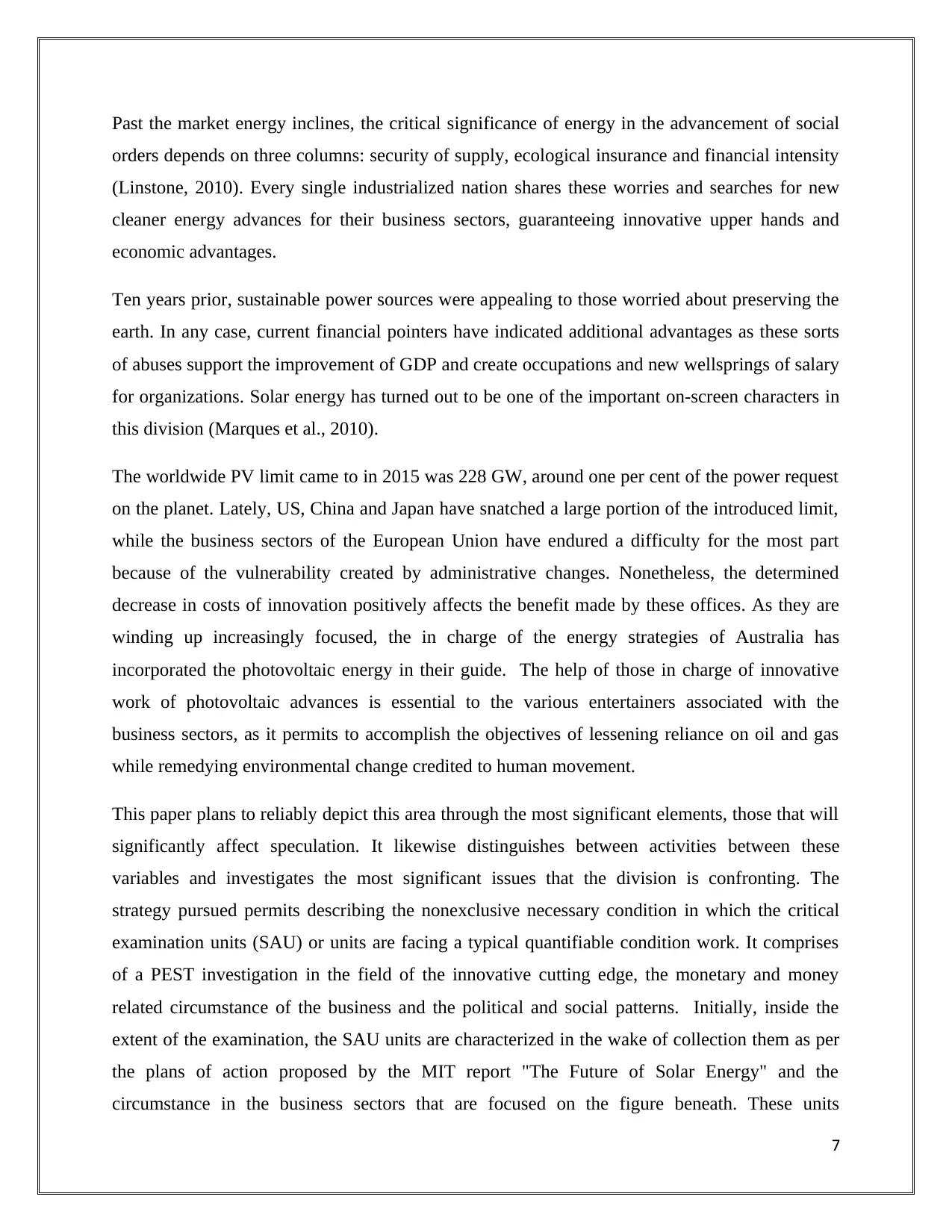
Past the market energy inclines, the critical significance of energy in the advancement of social
orders depends on three columns: security of supply, ecological insurance and financial intensity
(Linstone, 2010). Every single industrialized nation shares these worries and searches for new
cleaner energy advances for their business sectors, guaranteeing innovative upper hands and
economic advantages.
Ten years prior, sustainable power sources were appealing to those worried about preserving the
earth. In any case, current financial pointers have indicated additional advantages as these sorts
of abuses support the improvement of GDP and create occupations and new wellsprings of salary
for organizations. Solar energy has turned out to be one of the important on-screen characters in
this division (Marques et al., 2010).
The worldwide PV limit came to in 2015 was 228 GW, around one per cent of the power request
on the planet. Lately, US, China and Japan have snatched a large portion of the introduced limit,
while the business sectors of the European Union have endured a difficulty for the most part
because of the vulnerability created by administrative changes. Nonetheless, the determined
decrease in costs of innovation positively affects the benefit made by these offices. As they are
winding up increasingly focused, the in charge of the energy strategies of Australia has
incorporated the photovoltaic energy in their guide. The help of those in charge of innovative
work of photovoltaic advances is essential to the various entertainers associated with the
business sectors, as it permits to accomplish the objectives of lessening reliance on oil and gas
while remedying environmental change credited to human movement.
This paper plans to reliably depict this area through the most significant elements, those that will
significantly affect speculation. It likewise distinguishes between activities between these
variables and investigates the most significant issues that the division is confronting. The
strategy pursued permits describing the nonexclusive necessary condition in which the critical
examination units (SAU) or units are facing a typical quantifiable condition work. It comprises
of a PEST investigation in the field of the innovative cutting edge, the monetary and money
related circumstance of the business and the political and social patterns. Initially, inside the
extent of the examination, the SAU units are characterized in the wake of collection them as per
the plans of action proposed by the MIT report "The Future of Solar Energy" and the
circumstance in the business sectors that are focused on the figure beneath. These units
7
orders depends on three columns: security of supply, ecological insurance and financial intensity
(Linstone, 2010). Every single industrialized nation shares these worries and searches for new
cleaner energy advances for their business sectors, guaranteeing innovative upper hands and
economic advantages.
Ten years prior, sustainable power sources were appealing to those worried about preserving the
earth. In any case, current financial pointers have indicated additional advantages as these sorts
of abuses support the improvement of GDP and create occupations and new wellsprings of salary
for organizations. Solar energy has turned out to be one of the important on-screen characters in
this division (Marques et al., 2010).
The worldwide PV limit came to in 2015 was 228 GW, around one per cent of the power request
on the planet. Lately, US, China and Japan have snatched a large portion of the introduced limit,
while the business sectors of the European Union have endured a difficulty for the most part
because of the vulnerability created by administrative changes. Nonetheless, the determined
decrease in costs of innovation positively affects the benefit made by these offices. As they are
winding up increasingly focused, the in charge of the energy strategies of Australia has
incorporated the photovoltaic energy in their guide. The help of those in charge of innovative
work of photovoltaic advances is essential to the various entertainers associated with the
business sectors, as it permits to accomplish the objectives of lessening reliance on oil and gas
while remedying environmental change credited to human movement.
This paper plans to reliably depict this area through the most significant elements, those that will
significantly affect speculation. It likewise distinguishes between activities between these
variables and investigates the most significant issues that the division is confronting. The
strategy pursued permits describing the nonexclusive necessary condition in which the critical
examination units (SAU) or units are facing a typical quantifiable condition work. It comprises
of a PEST investigation in the field of the innovative cutting edge, the monetary and money
related circumstance of the business and the political and social patterns. Initially, inside the
extent of the examination, the SAU units are characterized in the wake of collection them as per
the plans of action proposed by the MIT report "The Future of Solar Energy" and the
circumstance in the business sectors that are focused on the figure beneath. These units
7
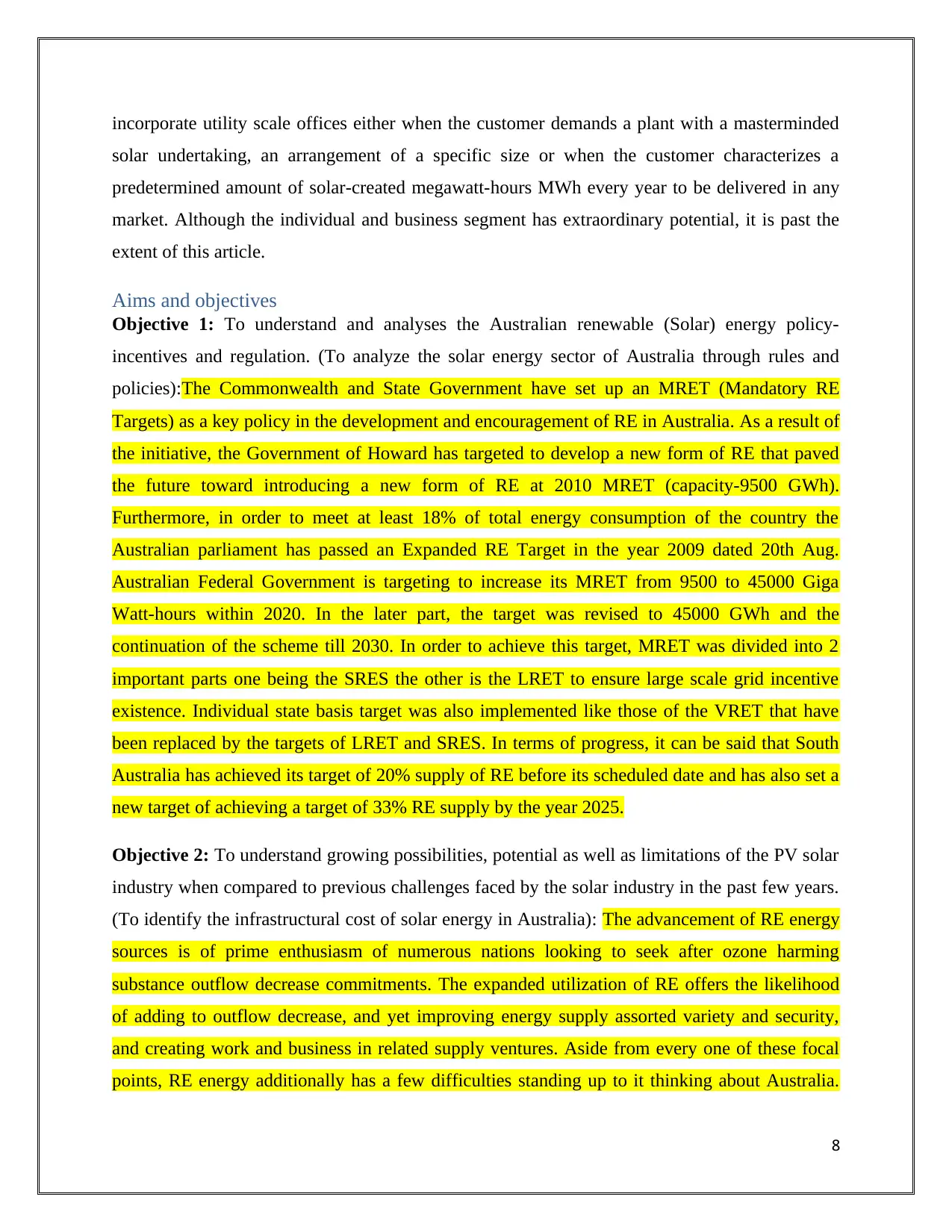
incorporate utility scale offices either when the customer demands a plant with a masterminded
solar undertaking, an arrangement of a specific size or when the customer characterizes a
predetermined amount of solar-created megawatt-hours MWh every year to be delivered in any
market. Although the individual and business segment has extraordinary potential, it is past the
extent of this article.
Aims and objectives
Objective 1: To understand and analyses the Australian renewable (Solar) energy policy-
incentives and regulation. (To analyze the solar energy sector of Australia through rules and
policies):The Commonwealth and State Government have set up an MRET (Mandatory RE
Targets) as a key policy in the development and encouragement of RE in Australia. As a result of
the initiative, the Government of Howard has targeted to develop a new form of RE that paved
the future toward introducing a new form of RE at 2010 MRET (capacity-9500 GWh).
Furthermore, in order to meet at least 18% of total energy consumption of the country the
Australian parliament has passed an Expanded RE Target in the year 2009 dated 20th Aug.
Australian Federal Government is targeting to increase its MRET from 9500 to 45000 Giga
Watt-hours within 2020. In the later part, the target was revised to 45000 GWh and the
continuation of the scheme till 2030. In order to achieve this target, MRET was divided into 2
important parts one being the SRES the other is the LRET to ensure large scale grid incentive
existence. Individual state basis target was also implemented like those of the VRET that have
been replaced by the targets of LRET and SRES. In terms of progress, it can be said that South
Australia has achieved its target of 20% supply of RE before its scheduled date and has also set a
new target of achieving a target of 33% RE supply by the year 2025.
Objective 2: To understand growing possibilities, potential as well as limitations of the PV solar
industry when compared to previous challenges faced by the solar industry in the past few years.
(To identify the infrastructural cost of solar energy in Australia): The advancement of RE energy
sources is of prime enthusiasm of numerous nations looking to seek after ozone harming
substance outflow decrease commitments. The expanded utilization of RE offers the likelihood
of adding to outflow decrease, and yet improving energy supply assorted variety and security,
and creating work and business in related supply ventures. Aside from every one of these focal
points, RE energy additionally has a few difficulties standing up to it thinking about Australia.
8
solar undertaking, an arrangement of a specific size or when the customer characterizes a
predetermined amount of solar-created megawatt-hours MWh every year to be delivered in any
market. Although the individual and business segment has extraordinary potential, it is past the
extent of this article.
Aims and objectives
Objective 1: To understand and analyses the Australian renewable (Solar) energy policy-
incentives and regulation. (To analyze the solar energy sector of Australia through rules and
policies):The Commonwealth and State Government have set up an MRET (Mandatory RE
Targets) as a key policy in the development and encouragement of RE in Australia. As a result of
the initiative, the Government of Howard has targeted to develop a new form of RE that paved
the future toward introducing a new form of RE at 2010 MRET (capacity-9500 GWh).
Furthermore, in order to meet at least 18% of total energy consumption of the country the
Australian parliament has passed an Expanded RE Target in the year 2009 dated 20th Aug.
Australian Federal Government is targeting to increase its MRET from 9500 to 45000 Giga
Watt-hours within 2020. In the later part, the target was revised to 45000 GWh and the
continuation of the scheme till 2030. In order to achieve this target, MRET was divided into 2
important parts one being the SRES the other is the LRET to ensure large scale grid incentive
existence. Individual state basis target was also implemented like those of the VRET that have
been replaced by the targets of LRET and SRES. In terms of progress, it can be said that South
Australia has achieved its target of 20% supply of RE before its scheduled date and has also set a
new target of achieving a target of 33% RE supply by the year 2025.
Objective 2: To understand growing possibilities, potential as well as limitations of the PV solar
industry when compared to previous challenges faced by the solar industry in the past few years.
(To identify the infrastructural cost of solar energy in Australia): The advancement of RE energy
sources is of prime enthusiasm of numerous nations looking to seek after ozone harming
substance outflow decrease commitments. The expanded utilization of RE offers the likelihood
of adding to outflow decrease, and yet improving energy supply assorted variety and security,
and creating work and business in related supply ventures. Aside from every one of these focal
points, RE energy additionally has a few difficulties standing up to it thinking about Australia.
8
⊘ This is a preview!⊘
Do you want full access?
Subscribe today to unlock all pages.

Trusted by 1+ million students worldwide
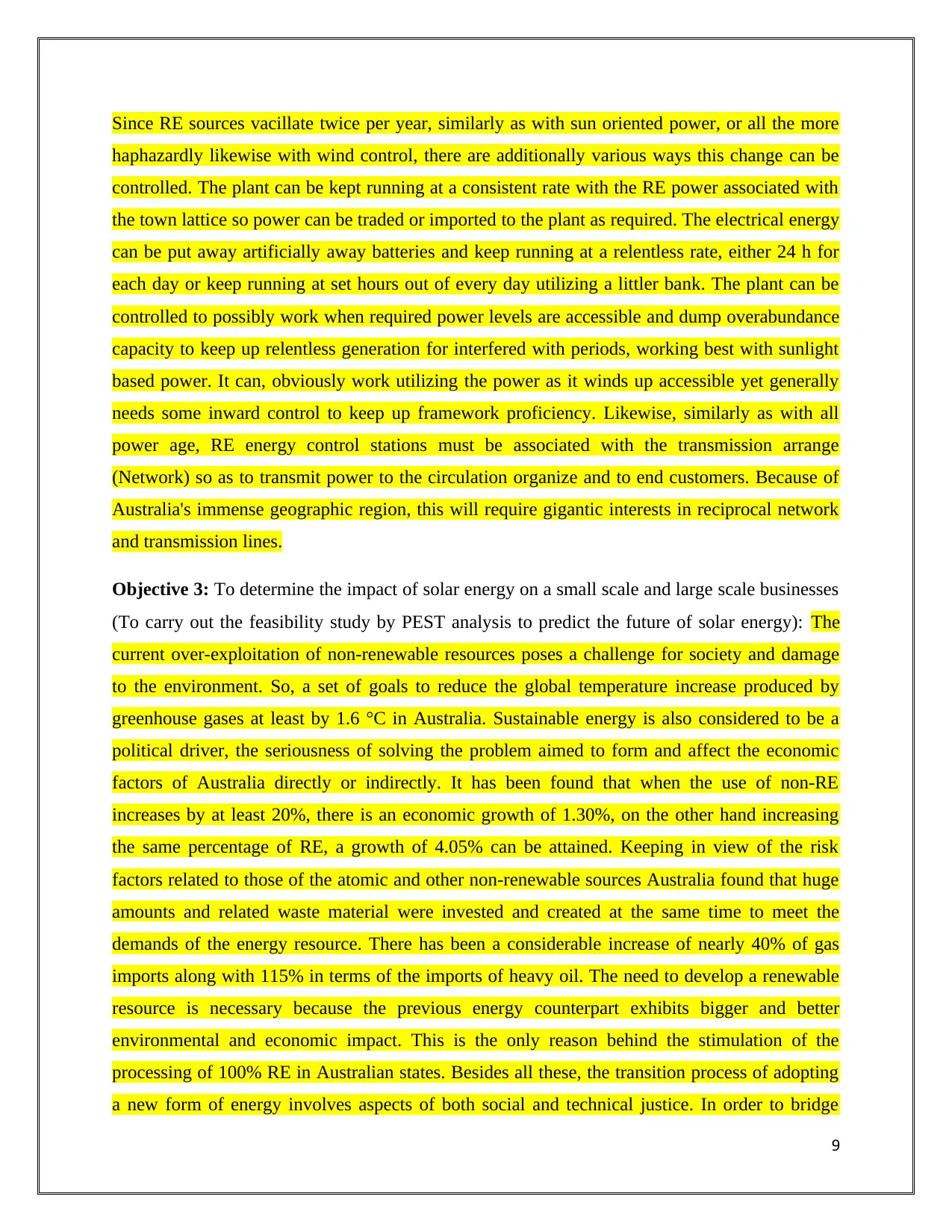
Since RE sources vacillate twice per year, similarly as with sun oriented power, or all the more
haphazardly likewise with wind control, there are additionally various ways this change can be
controlled. The plant can be kept running at a consistent rate with the RE power associated with
the town lattice so power can be traded or imported to the plant as required. The electrical energy
can be put away artificially away batteries and keep running at a relentless rate, either 24 h for
each day or keep running at set hours out of every day utilizing a littler bank. The plant can be
controlled to possibly work when required power levels are accessible and dump overabundance
capacity to keep up relentless generation for interfered with periods, working best with sunlight
based power. It can, obviously work utilizing the power as it winds up accessible yet generally
needs some inward control to keep up framework proficiency. Likewise, similarly as with all
power age, RE energy control stations must be associated with the transmission arrange
(Network) so as to transmit power to the circulation organize and to end customers. Because of
Australia's immense geographic region, this will require gigantic interests in reciprocal network
and transmission lines.
Objective 3: To determine the impact of solar energy on a small scale and large scale businesses
(To carry out the feasibility study by PEST analysis to predict the future of solar energy): The
current over-exploitation of non-renewable resources poses a challenge for society and damage
to the environment. So, a set of goals to reduce the global temperature increase produced by
greenhouse gases at least by 1.6 °C in Australia. Sustainable energy is also considered to be a
political driver, the seriousness of solving the problem aimed to form and affect the economic
factors of Australia directly or indirectly. It has been found that when the use of non-RE
increases by at least 20%, there is an economic growth of 1.30%, on the other hand increasing
the same percentage of RE, a growth of 4.05% can be attained. Keeping in view of the risk
factors related to those of the atomic and other non-renewable sources Australia found that huge
amounts and related waste material were invested and created at the same time to meet the
demands of the energy resource. There has been a considerable increase of nearly 40% of gas
imports along with 115% in terms of the imports of heavy oil. The need to develop a renewable
resource is necessary because the previous energy counterpart exhibits bigger and better
environmental and economic impact. This is the only reason behind the stimulation of the
processing of 100% RE in Australian states. Besides all these, the transition process of adopting
a new form of energy involves aspects of both social and technical justice. In order to bridge
9
haphazardly likewise with wind control, there are additionally various ways this change can be
controlled. The plant can be kept running at a consistent rate with the RE power associated with
the town lattice so power can be traded or imported to the plant as required. The electrical energy
can be put away artificially away batteries and keep running at a relentless rate, either 24 h for
each day or keep running at set hours out of every day utilizing a littler bank. The plant can be
controlled to possibly work when required power levels are accessible and dump overabundance
capacity to keep up relentless generation for interfered with periods, working best with sunlight
based power. It can, obviously work utilizing the power as it winds up accessible yet generally
needs some inward control to keep up framework proficiency. Likewise, similarly as with all
power age, RE energy control stations must be associated with the transmission arrange
(Network) so as to transmit power to the circulation organize and to end customers. Because of
Australia's immense geographic region, this will require gigantic interests in reciprocal network
and transmission lines.
Objective 3: To determine the impact of solar energy on a small scale and large scale businesses
(To carry out the feasibility study by PEST analysis to predict the future of solar energy): The
current over-exploitation of non-renewable resources poses a challenge for society and damage
to the environment. So, a set of goals to reduce the global temperature increase produced by
greenhouse gases at least by 1.6 °C in Australia. Sustainable energy is also considered to be a
political driver, the seriousness of solving the problem aimed to form and affect the economic
factors of Australia directly or indirectly. It has been found that when the use of non-RE
increases by at least 20%, there is an economic growth of 1.30%, on the other hand increasing
the same percentage of RE, a growth of 4.05% can be attained. Keeping in view of the risk
factors related to those of the atomic and other non-renewable sources Australia found that huge
amounts and related waste material were invested and created at the same time to meet the
demands of the energy resource. There has been a considerable increase of nearly 40% of gas
imports along with 115% in terms of the imports of heavy oil. The need to develop a renewable
resource is necessary because the previous energy counterpart exhibits bigger and better
environmental and economic impact. This is the only reason behind the stimulation of the
processing of 100% RE in Australian states. Besides all these, the transition process of adopting
a new form of energy involves aspects of both social and technical justice. In order to bridge
9
Paraphrase This Document
Need a fresh take? Get an instant paraphrase of this document with our AI Paraphraser
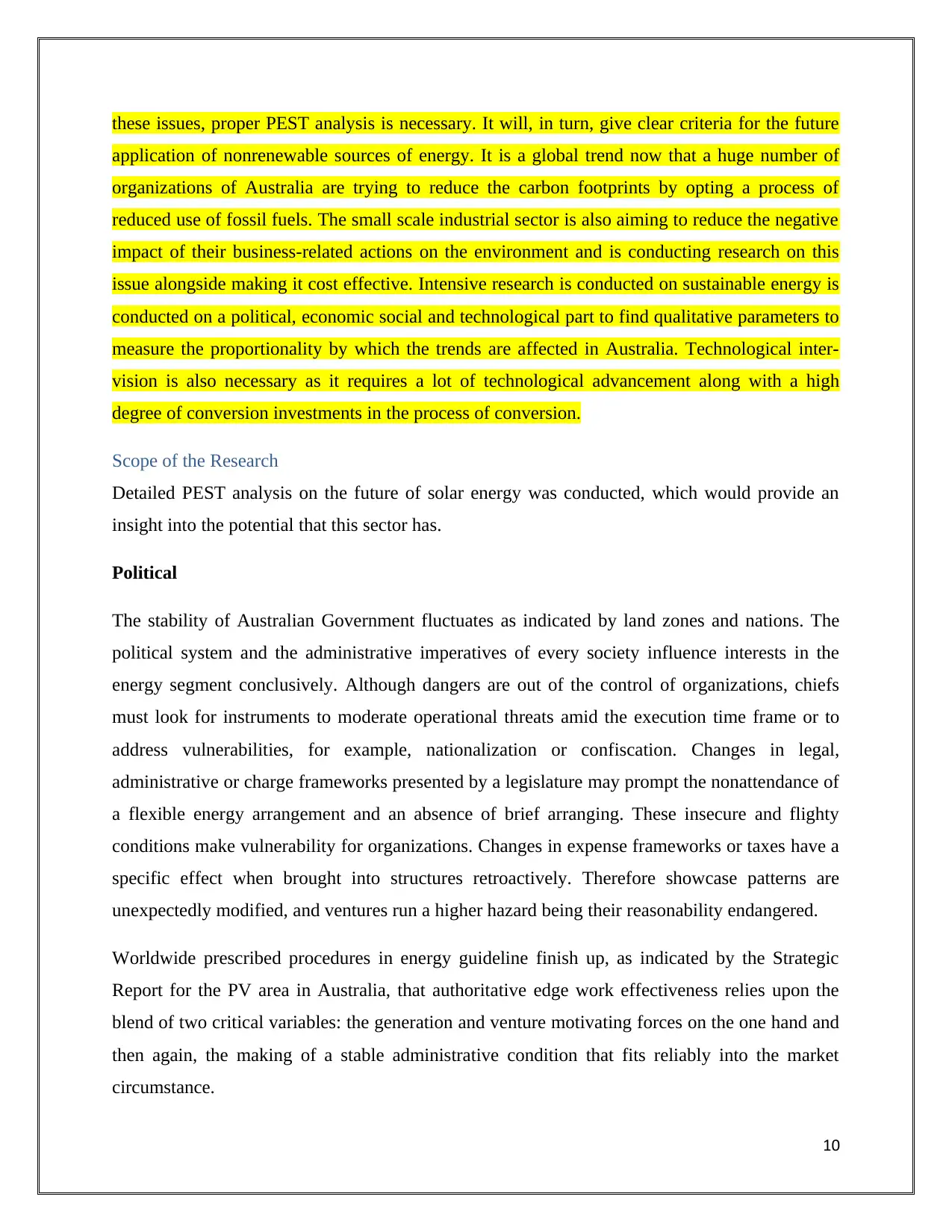
these issues, proper PEST analysis is necessary. It will, in turn, give clear criteria for the future
application of nonrenewable sources of energy. It is a global trend now that a huge number of
organizations of Australia are trying to reduce the carbon footprints by opting a process of
reduced use of fossil fuels. The small scale industrial sector is also aiming to reduce the negative
impact of their business-related actions on the environment and is conducting research on this
issue alongside making it cost effective. Intensive research is conducted on sustainable energy is
conducted on a political, economic social and technological part to find qualitative parameters to
measure the proportionality by which the trends are affected in Australia. Technological inter-
vision is also necessary as it requires a lot of technological advancement along with a high
degree of conversion investments in the process of conversion.
Scope of the Research
Detailed PEST analysis on the future of solar energy was conducted, which would provide an
insight into the potential that this sector has.
Political
The stability of Australian Government fluctuates as indicated by land zones and nations. The
political system and the administrative imperatives of every society influence interests in the
energy segment conclusively. Although dangers are out of the control of organizations, chiefs
must look for instruments to moderate operational threats amid the execution time frame or to
address vulnerabilities, for example, nationalization or confiscation. Changes in legal,
administrative or charge frameworks presented by a legislature may prompt the nonattendance of
a flexible energy arrangement and an absence of brief arranging. These insecure and flighty
conditions make vulnerability for organizations. Changes in expense frameworks or taxes have a
specific effect when brought into structures retroactively. Therefore showcase patterns are
unexpectedly modified, and ventures run a higher hazard being their reasonability endangered.
Worldwide prescribed procedures in energy guideline finish up, as indicated by the Strategic
Report for the PV area in Australia, that authoritative edge work effectiveness relies upon the
blend of two critical variables: the generation and venture motivating forces on the one hand and
then again, the making of a stable administrative condition that fits reliably into the market
circumstance.
10
application of nonrenewable sources of energy. It is a global trend now that a huge number of
organizations of Australia are trying to reduce the carbon footprints by opting a process of
reduced use of fossil fuels. The small scale industrial sector is also aiming to reduce the negative
impact of their business-related actions on the environment and is conducting research on this
issue alongside making it cost effective. Intensive research is conducted on sustainable energy is
conducted on a political, economic social and technological part to find qualitative parameters to
measure the proportionality by which the trends are affected in Australia. Technological inter-
vision is also necessary as it requires a lot of technological advancement along with a high
degree of conversion investments in the process of conversion.
Scope of the Research
Detailed PEST analysis on the future of solar energy was conducted, which would provide an
insight into the potential that this sector has.
Political
The stability of Australian Government fluctuates as indicated by land zones and nations. The
political system and the administrative imperatives of every society influence interests in the
energy segment conclusively. Although dangers are out of the control of organizations, chiefs
must look for instruments to moderate operational threats amid the execution time frame or to
address vulnerabilities, for example, nationalization or confiscation. Changes in legal,
administrative or charge frameworks presented by a legislature may prompt the nonattendance of
a flexible energy arrangement and an absence of brief arranging. These insecure and flighty
conditions make vulnerability for organizations. Changes in expense frameworks or taxes have a
specific effect when brought into structures retroactively. Therefore showcase patterns are
unexpectedly modified, and ventures run a higher hazard being their reasonability endangered.
Worldwide prescribed procedures in energy guideline finish up, as indicated by the Strategic
Report for the PV area in Australia, that authoritative edge work effectiveness relies upon the
blend of two critical variables: the generation and venture motivating forces on the one hand and
then again, the making of a stable administrative condition that fits reliably into the market
circumstance.
10
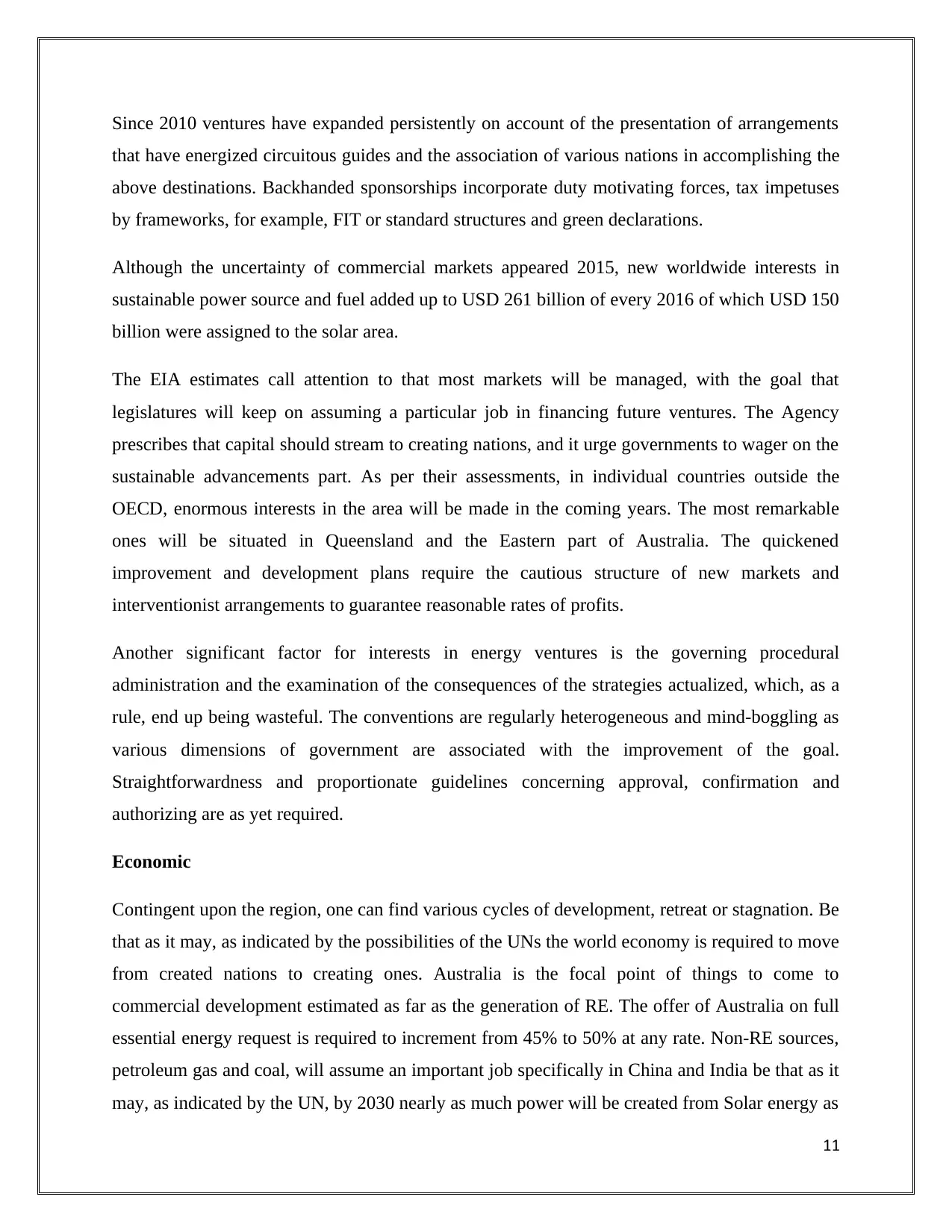
Since 2010 ventures have expanded persistently on account of the presentation of arrangements
that have energized circuitous guides and the association of various nations in accomplishing the
above destinations. Backhanded sponsorships incorporate duty motivating forces, tax impetuses
by frameworks, for example, FIT or standard structures and green declarations.
Although the uncertainty of commercial markets appeared 2015, new worldwide interests in
sustainable power source and fuel added up to USD 261 billion of every 2016 of which USD 150
billion were assigned to the solar area.
The EIA estimates call attention to that most markets will be managed, with the goal that
legislatures will keep on assuming a particular job in financing future ventures. The Agency
prescribes that capital should stream to creating nations, and it urge governments to wager on the
sustainable advancements part. As per their assessments, in individual countries outside the
OECD, enormous interests in the area will be made in the coming years. The most remarkable
ones will be situated in Queensland and the Eastern part of Australia. The quickened
improvement and development plans require the cautious structure of new markets and
interventionist arrangements to guarantee reasonable rates of profits.
Another significant factor for interests in energy ventures is the governing procedural
administration and the examination of the consequences of the strategies actualized, which, as a
rule, end up being wasteful. The conventions are regularly heterogeneous and mind-boggling as
various dimensions of government are associated with the improvement of the goal.
Straightforwardness and proportionate guidelines concerning approval, confirmation and
authorizing are as yet required.
Economic
Contingent upon the region, one can find various cycles of development, retreat or stagnation. Be
that as it may, as indicated by the possibilities of the UNs the world economy is required to move
from created nations to creating ones. Australia is the focal point of things to come to
commercial development estimated as far as the generation of RE. The offer of Australia on full
essential energy request is required to increment from 45% to 50% at any rate. Non-RE sources,
petroleum gas and coal, will assume an important job specifically in China and India be that as it
may, as indicated by the UN, by 2030 nearly as much power will be created from Solar energy as
11
that have energized circuitous guides and the association of various nations in accomplishing the
above destinations. Backhanded sponsorships incorporate duty motivating forces, tax impetuses
by frameworks, for example, FIT or standard structures and green declarations.
Although the uncertainty of commercial markets appeared 2015, new worldwide interests in
sustainable power source and fuel added up to USD 261 billion of every 2016 of which USD 150
billion were assigned to the solar area.
The EIA estimates call attention to that most markets will be managed, with the goal that
legislatures will keep on assuming a particular job in financing future ventures. The Agency
prescribes that capital should stream to creating nations, and it urge governments to wager on the
sustainable advancements part. As per their assessments, in individual countries outside the
OECD, enormous interests in the area will be made in the coming years. The most remarkable
ones will be situated in Queensland and the Eastern part of Australia. The quickened
improvement and development plans require the cautious structure of new markets and
interventionist arrangements to guarantee reasonable rates of profits.
Another significant factor for interests in energy ventures is the governing procedural
administration and the examination of the consequences of the strategies actualized, which, as a
rule, end up being wasteful. The conventions are regularly heterogeneous and mind-boggling as
various dimensions of government are associated with the improvement of the goal.
Straightforwardness and proportionate guidelines concerning approval, confirmation and
authorizing are as yet required.
Economic
Contingent upon the region, one can find various cycles of development, retreat or stagnation. Be
that as it may, as indicated by the possibilities of the UNs the world economy is required to move
from created nations to creating ones. Australia is the focal point of things to come to
commercial development estimated as far as the generation of RE. The offer of Australia on full
essential energy request is required to increment from 45% to 50% at any rate. Non-RE sources,
petroleum gas and coal, will assume an important job specifically in China and India be that as it
may, as indicated by the UN, by 2030 nearly as much power will be created from Solar energy as
11
⊘ This is a preview!⊘
Do you want full access?
Subscribe today to unlock all pages.

Trusted by 1+ million students worldwide
1 out of 34
Your All-in-One AI-Powered Toolkit for Academic Success.
+13062052269
info@desklib.com
Available 24*7 on WhatsApp / Email
![[object Object]](/_next/static/media/star-bottom.7253800d.svg)
Unlock your academic potential
Copyright © 2020–2025 A2Z Services. All Rights Reserved. Developed and managed by ZUCOL.
